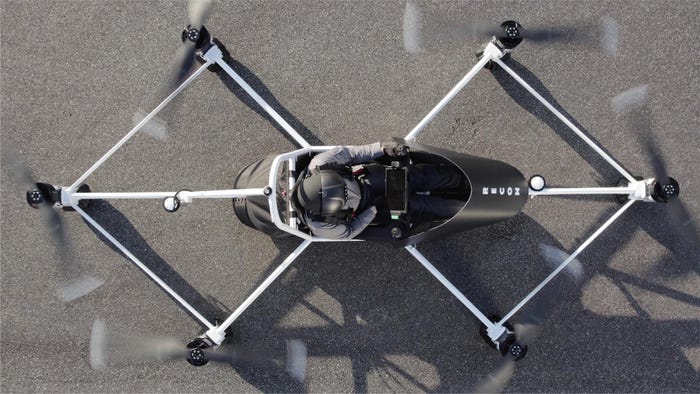Personal Flying Vehicle Converted for FarmingPersonal Flying Vehicle Converted for Farming
Ryse Aero Technology devised a way to modify its electric flying vehicle to be used to fertilize farmland

Personal eVTOL (electric vertical takeoff and landing) vehicles can be used for more than just recreational use, based on what Ryse Aero Technology is planning for its electric aerial vehicle (EAV).
Ryse Aero, founded in 2021, is on its third generation of personal air vehicle and plans to deliver its EAVs in 2014.
However, the Ohio startup has created different use cases for its vehicles.
As a member of the ultralight category of EAV, which does not require a pilot license to fly under Federal Aviation Administration (FAA) rules, the Ryse Recon vehicle can be used for pure recreational flying.

This is true of most other EAVs in this category being developed and launched in 2024.
However, the Ryse Recon can also be used for other things.
For example, one use by an entrepreneur is to fly the vehicle to get to the other side of a lake, rather than driving all the way around.
The risk here is limited since the Ryse Recon can land and take off on water, as was demonstrated in a recent video.
In the world of agriculture, farmers could use the vehicle to quickly fly to a farm location to check on an irrigation problem or to monitor crops. That would be a pure, short transportation function.
The vehicle has technology built in that could limit usage to over the designated farmland, according to CEO Mick Howitz.
The vehicle also could be used to treat crops.
There are land-based framing solutions for this.
For example, John Deere has sophisticated technology, including using Nvidia processors on a large boom pulled behind a tractor. That allows a machine to go through a field using computer vision to distinguish between crops and weeds and spray each accordingly with either fertilizer or weed killer.
Drones can be used for a similar function, albeit with limited fertilizer-carrying capacity and not as precise.
At Ryse Aero, Kowitz and team devised a way to convert its EAV for a farming-focused spraying application.
Rather than a person sitting in the single-passenger seat, a large container for fertilizer takes the seat.
Ryse created a boom that can be inserted into the sides of the EAV and then it can be operated remotely by a farmer.
The EAV can carry significantly more fertilizer than a drone and cover a wider area.
The vehicle, which runs on batteries with a flight time in the range of 20 to 30 minutes, would just need charging or battery swapping between runs.
The larger, certified EAVs under development, such as air taxis, require certification from the FAA, a licensed pilot and vertiports for landing, takeoff, passenger pickup and drop-off and battery charging.
Although most EAVs take off and land straight up and down, the commercial flying vehicles of the future require significantly more infrastructure for operation.
The ultralight category, such as the Ryse Recon, involves vehicles aimed at single ownership and usage with the ability for one person to manage the craft.
The Ryse Recon is among several new personal flying vehicles entering the market in 2024.
This is the third in a series of stories and videos taking an inside look at personal flying vehicle startup Ryse Aero.
Like what you've read? For more stories like this on flying cars and emerging technologies, sign up for our free daily email newsletter to stay updated!
Read more about:
Flying CarsAbout the Author
You May Also Like







